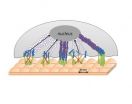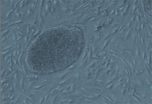(Press-News.org) PROVIDENCE, R.I. [Brown University] -- One in eight women in the United States will develop breast cancer. Of those, many will undergo surgery to remove the tumor and will require some kind of breast reconstruction afterward, often involving implants. Cancer is an elusive target, though, and malignant cells return for as many as one-fifth of women originally diagnosed, according to the American Cancer Society.
Would it be possible to engineer implant materials that might drive down that rate of relapse? Brown University biomedical scientists report some promising advances. The team has created an implant with a "bed-of-nails" surface at the nanoscale (dimensions one-billionth of a meter, or 1/50,000th the width of a human hair) that deters cancer cells from dwelling and thriving. Made out of a common federally approved polymer, the implant is the first of its kind, based on a review of the literature, with modifications at the nanoscale that cause a reduction in the blood-vessel architecture on which breast cancer tumors depend — while also attracting healthy breast cells.
"We've created an (implant) surface with features that can at least decrease (cancerous) cell functions without having to use chemotherapeutics, radiation, or other processes to kill cancer cells," said Thomas Webster, associate professor of engineering and the corresponding author on the paper in Nanotechnology. "It's a surface that's hospitable to healthy breast cells and less so for cancerous breast cells."
Webster and his lab have been modifying various implant surfaces to promote the regeneration of bone, cartilage, skin, and other cells. In this work, he and Lijuan Zhang, a fourth-year graduate student in chemistry, sought to reshape an implant that could be used in breast reconstruction surgery that would not only attract healthy cells but also repel any lingering breast-cancer cells. The duo created a cast on a glass plate using 23-nanometer-diameter polystyrene beads and polylactic-co-glycolic acid (PLGA), a biodegradable polymer approved by the FDA and used widely in clinical settings, such as stitches. The result: An implant whose surface was covered with adjoining, 23-nanometer-high pimples. The pair also created PLGA implant surfaces with 300-nanometer and 400-nanometer peaks for comparison.
In lab tests after one day, the 23-nanometer-peak surfaces showed a 15-percent decrease in the production of a protein (VEGF) upon which endothelial breast-cancer cells depend, compared to an implant surface with no surface modification. The 23-nanometer surface showed greater reduction in VEGF concentration when compared to the 300-nanometer and 400-nanometer-modified implants as well.
It's unclear why the 23-nanoneter surface appears to work best at deterring breast-cancer cells. Webster thinks it may have to do something with the stiffness of malignant breast cells. When they come into contact with the bumpy surface, they are unable to fully wrap themselves around the rounded contours, depriving them of the ability to ingest the life-sustaining nutrients that permeate the surface.
"This is like a bed-of-nails surface to them," Webster said.
"I would guess that surface peaks less than 23 nanometers would be even better," Webster added, although polystyrene beads with such dimensions don't yet exist. "The more you can push up that cancerous cell, the more you keep it from interacting with the surface."
The pair also found that the 23-nanometer semispherical surface yielded 15 percent more healthy endothelial breast cells compared to normal surface after one day of lab tests.
Webster and Zhang next plan to investigate why the nanomodified surfaces deter malignant breast cells, to create surface features that yield greater results, and to determine whether other materials can be used.
INFORMATION:
The National Institutes of Health's National Center for Research Resources and the Hermann Foundation funded the research. Michael Platek at the University of Rhode Island helped with the electron spectroscopy for chemical analysis.
'Bed-of-nails' breast implant deters cancer cells
2012-03-26
ELSE PRESS RELEASES FROM THIS DATE:
Huge hamsters and pint-sized porcupines thrive on islands
2012-03-26
DURHAM, N.C. -- From miniature elephants to monster mice, and even Hobbit-sized humans, size changes in island animals are well-known to science. Biologists have long believed that large animals evolving on islands tend to get smaller, while small animals tend to get bigger, a generalization they call "the island rule."
A new study by researchers at Duke University and the National Evolutionary Synthesis Center in Durham, NC puts that old idea to the test in island and mainland rodents.
"Some of the size changes observed in island animals are pretty dramatic," said ...
Researchers unveil robot jellyfish built on nanotechnology
2012-03-26
Researchers at The University of Texas at Dallas and Virginia Tech have created an undersea vehicle inspired by the common jellyfish that runs on renewable energy and could be used in ocean rescue and surveillance missions.
In a study published this week in Smart Materials and Structures, scientists created a robotic jellyfish, dubbed Robojelly, that feeds off hydrogen and oxygen gases found in water.
"We've created an underwater robot that doesn't need batteries or electricity," said Dr. Yonas Tadesse, assistant professor of mechanical engineering at UT Dallas and ...
Possible causes of sudden onset OCD in kids broadened
2012-03-26
Criteria for a broadened syndrome of acute onset obsessive compulsive disorder (OCD) have been proposed by a National Institutes of Health scientist and her colleagues. The syndrome, Pediatric Acute-onset Neuropsychiatric Syndrome (PANS), includes children and teens that suddenly develop on-again/off-again OCD symptoms or abnormal eating behaviors, along with other psychiatric symptoms – without any known cause.
PANS expands on Pediatric Autoimmune Neuropsychiatric Disorder Associated with Streptococcus (PANDAS), which is limited to a subset of cases traceable to ...
UN hits water target, but 1.8 billion people still drinking unsafe water, study shows
2012-03-26
Recent widespread news coverage heralded the success of a United Nations' goal of greatly improving access to safe drinking water around the world.
But while major progress has been made, a new study from the University of North Carolina at Chapel Hill indicates that far greater challenges persist than headline statistics suggested.
Earlier this month (March 6), UNICEF and the World Health Organization issued a report stating that the world had met the U.N.'s Millennium Development Goal target of halving the proportion of people without access to safe drinking water, ...
Mountaintop blasting to mine the sky with the Giant Magellan Telescope
2012-03-26
Pasadena, CA--Astronomers have begun to blast 3 million cubic feet of rock from a mountaintop in the Chilean Andes to make room for what will be the world's largest telescope when completed near the end of the decade. The telescope will be located at the Carnegie Institution's Las Campanas Observatory—one of the world's premier astronomical sites, known for its pristine conditions and clear, dark skies. Over the next few months, more than 70 controlled blasts will break up the rock while leaving a solid bedrock foundation for the telescope and its precision scientific instruments.
The ...
Learning best when you rest: Sleeping after processing new info most effective, new study shows
2012-03-26
Nodding off in class may not be such a bad idea after all. New research from the University of Notre Dame shows that going to sleep shortly after learning new material is most beneficial for recall,
Titled "Memory for Semantically Related and Unrelated Declarative Information:
The Benefit of Sleep, the Cost of Wake," the study was published March 22 in PLOS One.
Notre Dame Psychologist Jessica Payne and colleagues studied 207 students who habitually slept for at least six hours per night. Participants were randomly assigned to study declarative, semantically ...
Researchers discover why humans began walking upright
2012-03-26
WASHINGTON—Most of us walk and carry items in our hands every day. These are seemingly simple activities that the majority of us don't question. But an international team of researchers, including Brian Richmond at the George Washington University, have discovered that human bipedalism, or walking upright, may have originated millions of years ago as an adaptation to carrying scarce, high-quality resources. This latest research was published in this month's "Current Biology."
The team of researchers from the U.S., England, Japan and Portugal investigated the behavior ...
Researchers develop new technique to assess diversity of plant species from afar
2012-03-26
EAST LANSING, Mich. --- By analyzing vegetation information collected by satellites over time instead of for just one day, scientists in the Michigan State University Center for Systems Integration and Sustainability (CSIS) have developed a novel procedure to assess the composition of plant species in an area.
Researchers long have used multi-spectral images (which include radiation outside human perception, such as infrared) and other remotely sensed data to create maps of vegetation around the globe. But seasonal changes in vegetation can limit the usefulness of these ...
Embryonic stem cells shift metabolism in cancer-like way upon implanting in uterus
2012-03-26
Shortly after a mouse embryo starts to form, some of its stem cells undergo a dramatic metabolic shift to enter the next stage of development, Seattle researchers report today. These stem cells start using and producing energy like cancer cells.
This discovery is published today in EMBO, the European Molecular Biology Organization journal.
"These findings not only have implications for stem cell research and the study of how embryos grow and take shape, but also for cancer therapy," said the senior author of the study, Dr. Hannele Ruohola-Baker, University of Washington ...
A shiny new tool for imaging biomolecules
2012-03-26
At the heart of the immune system that protects our bodies from disease and foreign invaders is a vast and complex communications network involving millions of cells, sending and receiving chemical signals that can mean life or death. At the heart of this vast cellular signaling network are interactions between billions of proteins and other biomolecules. These interactions, in turn, are greatly influenced by the spatial patterning of signaling and receptor molecules. The ability to observe signaling spatial patterns in the immune and other cellular systems as they evolve, ...




